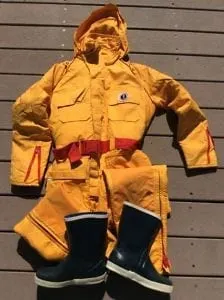Sailing at night: tactics and tips
As an early-to-bed person, I find a night passage offers special and sublime opportunities for stargazing, precious alone time, and quiet contemplation. However, I’ve also found myself wet, cold, and not-so-quietly contemplating the lights of a ship bearing down on us. Does that tanker see us? Fortunately, after 3,000 nautical miles of trial and error while sailing from Canada to Mexico, my partner, Robin, and I have learned a few tricks that make night passages more comfortable and serene.
Feed the crew
Good hot food makes all the difference in keeping energy (and spirits) up on a night passage, especially when very little cooking is involved.
Minimize galley time – It takes three days for most sailors to get their sea legs, so we like to have no- to low-effort meals and snacks planned for those first days at sea. Less time spent in the galley also means we have more time for the boat, rest, and sleeping. To minimize galley time, we prepare all our food for the first 24 hours at sea ahead of time. One of our go-to evening meals is soup, made in advance and kept warm in a thermos on deck. After the first 24 hours, quick-to-make meals (canned soup, beans on toast, curry in a bag) are a good bet.
Splurge on fun treats – We stock a “sin bin” with trail mix, chips, and chocolate and also prepare some of our favorite nibbles (muffins, scones, cinnamon buns). Milk chocolate is good for a jolt of energy, but doesn’t keep us up past our watches.
Stay hydrated
Water is very important for keeping the mind alert on night watch. In fact, dehydration is often mistaken for fatigue.
Keep a water bottle on deck – One of our friends has a rule that anyone who yawns on the boat must take a drink of water. Every member of the crew should keep a water bottle on deck when on watch. As well as making water accessible, this is a good way to monitor intake.
Serve warm drinks – One of our favorite hot drinks is Chai tea, kept in a thermos in the cockpit. We make it by adding an inch of fresh ginger to three cups of water, bringing it to a boil, and then adding cardamom, honey, and black pepper to taste. The spices and honey give us a boost without the diuretic and stimulating effects of caffeine. Cider (the soft kind!), tea, and hot chocolate are great too.
Sleep, glorious sleep
Sleep can feel scarce when sailing overnight, but we take steps to manage it.
Sleep before leaving – First, we make sure we’re well rested before we leave. We never start a passage with a sleep deficit.
A workable watch schedule – Sailors use many different watch schedules and tailor them to the number of crew on board. To find out what works best for us, we started with shorter watches (of perhaps 1 to 2 hours) and increased the length over time. We usually sail with just the two of us (plus autopilot) and find 3-hour watches work well, but on many occasions we’ve gone to shorter watches because one of us was not able to stay alert for the full 3 hours. If you’re hand steering, definitely err on the side of shorter watches. And when you feel like you can’t keep your eyes open, it is always better to wake your partner than risk snoozing at the wheel.
Avoid alcohol and stimulants – One of the principal ways we improve the quantity and quality of our sleep on board is to avoid alcohol, caffeine, and other stimulating drugs. The half-life of caffeine is 4 to 6 hours in humans, so the chances are, someone who drinks a cup of tea at the beginning of a 3-hour watch will still be feeling the effects at the end of it. When this happens, it’s then tempting to use alcohol or sleeping pills to get to sleep. Alcohol has been proven to reduce the quality of sleep. The result is waking up feeling more tired and feeling the need for more coffee, and thus the vicious loop repeats.
Try light sleep aids – One sleep aid to consider using is the seasickness medication Gravol. Someone already taking Gravol for seasickness might consider timing the dose at one-half hour before the end of a night watch. This gives the Gravol time to kick in, aiding sleep at just the right time. By the time the off-watch is over, the Gravol has been partially processed and, you hope, the effect is less drowsiness and no seasickness. For those not taking Gravol, a cup of chamomile or valerian tea half an hour before the end of their watch will help sleep come more quickly.
Get comfy – We made sure we had a safe and comfortable sea berth by setting up a snug leecloth on a berth close to the boat’s center of gravity, where the the off-watch sleeper would feel the least motion (see “Make your own Leecloth,” January 2017). Earplugs and an eye mask help reduce stimuli to further aid sleep.
Staying awake
Staying awake on night watch can be difficult, but we engage in a number of activities to help us keep our eyes open.
Stay occupied – If we don’t keep ourselves lightly occupied on night watch, we find it difficult to stay awake, so we create watch routines that keep us focused and alert. Filling out our ship’s log is one such task. I’ve learned that one of the most effective things I can do to avoid dropping off is to keep my brain engaged in some light listening (podcasts, music, audiobooks) through a single earbud. This keeps me awake while I scan the horizon and listen for any changes in the boat or environment. If you’re in need of something to listen to, check out the salty audiobooks at Audioseastories.com, GoodOld Boat’s online store.
Keep moving – When I get overly drowsy, I stand up and dance in the cockpit. Though I might look ridiculous, it gets the blood moving and keeps me sharp a bit longer. If dancing is not your thing, stretching or jogging in place also works.
Set alarms – When I find I’m feeling a bit droopy-eyed, I set a wristwatch alarm to go off every 10 minutes, just to catch me in case I do accidentally doze off. Of course, if I do fall asleep, I realize as soon as I wake that my best option is to wake someone else to take the watch.
What to wear
It’s hard for me to appreciate the beautiful starlit sky when I have wet feet. I prefer to stay warm and dry.
Rubber boots and foulies –My favorite piece of gear is a 1980s yellow Mustang survival suit I picked up in a thrift store. While higher-tech options are available, I love my survival suit because it’s like wearing a giant sleeping bag on deck. I have foulies (foul weather gear), too, which are great for more active sailing, but when I’m hunkered down in the cockpit all night, my chief concern is staying warm. The other great thing about the survival suit is that I stay warm even if it gets wet. I once took a wave down the back of my survival suit and, though wet, I was warm again in less than a minute.
Buy some bum padding – Deck cushions can get in the way while sailing, so we usually stow them. I sometimes wear
a pair of padded cycling shorts under my foulies to provide some insulation from the hard, cold cockpit seats.
No cotton garments! – Or atleast don’t wear them on chilly nights. When the least bit damp, cotton can get cold and clammy. We choose wool, polyester, and other technical fabrics for layering as they don’t hold moisture against the skin.
Clip in – A tether and harness are musts for enjoyment and comfort while sailing at night. We much prefer the view of the ocean from the boat than the boat from the ocean. Plus, the off-watch rests easier knowing the on-watch is tethered safely to the boat.
Warding off the green
Perhaps the number-one thing we do to ensure our comfort while afloat is avoid getting seasick. Many remedies are available, including Gravol, Dramamine, Transderm-V patch, ginger, and acupressure wrist bands. We try any drug or remedy on dry land before taking it while sailing, just in case we experience a negative side effect. One seasickness medication on the market made my vision blurry. Once you’ve found something that works for you, start taking it at least 12 hours before setting sail so it has time to properly kick in. We are often helped by spending a couple of nights in a slightly rolly anchorage before heading out.
Bits and bytes – Two pieces of technology are a boon for any sailor venturing out under the cover of darkness.
Autopilot – An autopilot helps minimize crew fatigue. Handsteering becomes far more challenging and tiring at night, when limited visibility can affect orientation. An autopilot allows for longer and more restful watches.
AIS – If you have it, AIS is a terrific additional source of information at night. It’s a great comfort to know the course and speed of the twinkly bright lights bearing down on us in the darkness. We can easily hail the vessel in question, by its name, if that’s listed on the AIS target, or by private hailing its MMSI number using the DSC-enabled VHF. Once in contact, we ask whether they can see our boat and whether they plan to alter course in the near future. We like to set our
AIS alarm so we don’t miss any vessels that will approach within 2 nautical miles.
Passage planning
The decisions we make before leaving the dock undoubtedly have the greatest impact on the comfort of our night sail.
Choosing a weather window – Poor weather and sea conditions become considerably less fun in the dark, so we plan around adverse weather. We avoid night passages when the swell period (in seconds) and height (in feet) are close in number. For example, a 7-foot swell with a 12-second period will be a lot more comfortable than a 7-foot swell with a 7-second period.
Sail in your comfort zone –
If you’re comfortable sailing in up to 20 knots of wind, limit overnight passages to wind conditions of 15 knots or less. Conditions can feel a lot bigger at night and so we
do not push ourselves past our comfort limits, and we sleep better as a result.
Use the full moon – We’re much more comfortable on night passages when the moon is full or nearly full. All that light makes it easier to spot obstacles and we’re psychologically more at ease when we are able to see our surroundings.
Leave and arrive in daylight – The approaches to many ocean ports are littered with crab traps, long-lines,dead-heads, kelp, and other debris. We prefer to heave-to for a couple of hours rather than risk fouling our propeller attempting an entrance in the dead of night.
Passages of manageable length – If you’re new to sailing at night, it’s a good idea to slowly build up to longer and longer sails. As you start planning multi-night voyages, think about the best way to break the passages down. Many solo sailors we know choose to never sail more than one night at a time so they can pull in and have rest days after each night passage. Personally, we like trips that are three days or longer, because we find it takes that long to adjust our sleeping patterns. Experiment with different passage lengths until you find a style that leaves you feeling rested.
Strategies for sailing at night
Whether we feel safe and comfortable at night has a lot to do with how we set our sails. Proper planning makes the difference between restful slumber and a sleepless night for the whole crew.
Prepare before dark – We complete the necessary tasks —like setting the sails and organizing the cockpit — in daylight so the crew on night watch has fewer things to focus on.
Brighten up – To avoid things that go bump in the night, invest in some good lighting. We were sailing down the Mexican coast and noticed a large trawler tailing us. We tried to radio the trawler only to realize that it was our buddy-boater, Jim, who had cunningly invested in high-wattage lights that made his 35-foot sloop appear to be a much larger vessel. We’ve found red lights and headlamps help us to get around the boat without impairing our night vision.
Set sails for comfort – We don’t sleep well with a slamming mainsail on a rolling boat. We play with different sail plans and courses to make our boat as comfortable and quiet as possible. We use a boom preventer, for example, to reduce the motion and noise of the mainsail. When sailing dead downwind makes things very rolly, we’ll head up a bit for a smoother ride. Our VMG (velocity made good) might suffer, but that’s preferable to having a tired crew. When we’re dealing with light and variable wind at night, we find it well worth the extra fuel cost to run the engine, so the person below can get some sleep.
Slow down at night – We usually take in a reef before dark. We might lose some speed, but our boat is a lot more manageable if the wind picks up later — and we don’t have to put in that reef at night.
Schedule maneuvers – When possible, we plan our maneuvers, such as tacking and gybing, so we can do them before it gets dark. We schedule them for watch changes to minimize the number of times we need to wake someone mid-sleep for help on deck.
By adopting these strategies, we’ve begun to really enjoy sailing at night. In fact, we’re finding now that we even prefer it, because it means we don’t lose a day of shore time upon arrival in a new port. With the right preparation, you can make nights at sea not only pleasant, but also special and beautiful times. So make things comfortable for yourself, try some tips to see what works best for you, and then sit back and enjoy the stars.
Originally published in Good Old Boat magazine in March/April 2017. For more great how-tos and DIY subscribe to Good Old Boat magazine using this exclusive Waterborne promo code.
Fiona McGlynn is an award-winning boating writer who created Waterborne as a place to learn about living aboard and traveling the world by sailboat. She has written for boating magazines including BoatUS, SAIL, Cruising World, and Good Old Boat. She’s also a contributing editor at Good Old Boat and BoatUS Magazine. In 2017, Fiona and her husband completed a 3-year, 13,000-mile voyage from Vancouver to Mexico to Australia on their 35-foot sailboat.





Islay
Monday 7th of December 2020
try Tradional Medicines Ginger Aid Tea. Make Thermos and keep it handy when some one starts to feel queazy have them sip a cup or two of warm Ginger Aid tea. Helps settle the stomach and keeps you warm a win win.
JB
Sunday 3rd of June 2018
While I also do just about everything mentioned in the article, as a singlehander, there are no crew changes, so making sure hot drinks (I like decaf Irish Breakfast tea with a couple of cinnamon sticks thrown in) and light snacks are within reach of the cockpit are very important. I also added glow in the dark draft strips to my sails and I've added glow in the dark stickers to the stanchion bases. I love night sailing—it's almost a religious experience being out there, sailing in calm seas under a full moon and a sea of stars above. One word of warning though, if you're new to astronomy, don't be surprised if that North Star you've been following turns out to be the 9:40 flight from Chicago...just saying.
Jim Shell
Friday 16th of June 2017
Good article.
The very best, THE VERY BEST, anti seasick remedy for me has been Motion Ease, sold at West Marine and Walmart. After many remedies were tried and were unsuccessful, Motion Ease was the first remedy that I found successful. We were in 38+knots of wind between Nassau and Eleuthra and the cook brought sandwich "fixins" into the cockpit. I was already seasick and could only manage a slice of bread and cheese wadded up in my fist. My wife remembered I had bought Motion Ease several years before but I had never tried it. She went below and brought up the tiny bottle. I rubbed one drop behind each ear and within 15 minutes I was eating a Dagwood sandwich! The remedy is applied to the skin area behind each ear and works even if you are already seasick. About $5 at Walmart, maybe more at West Marine.
Fiona
Friday 30th of June 2017
Thanks for the recommendation Jim! I've never tried Motion Ease but will definitely give it a go now.